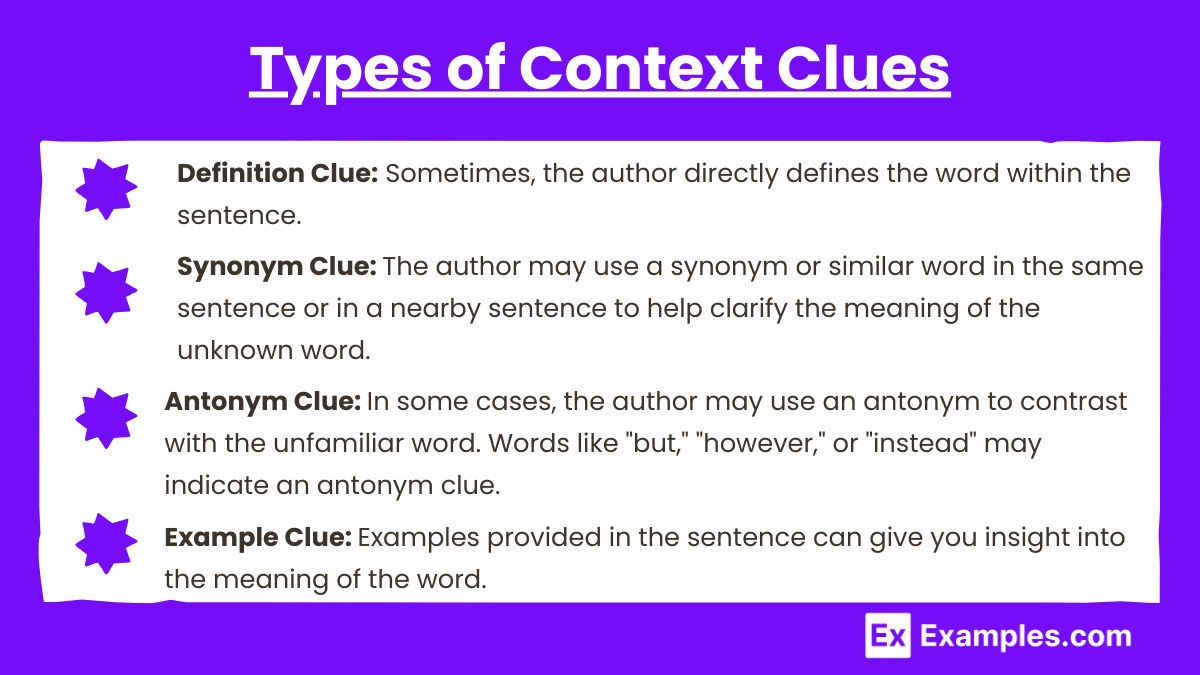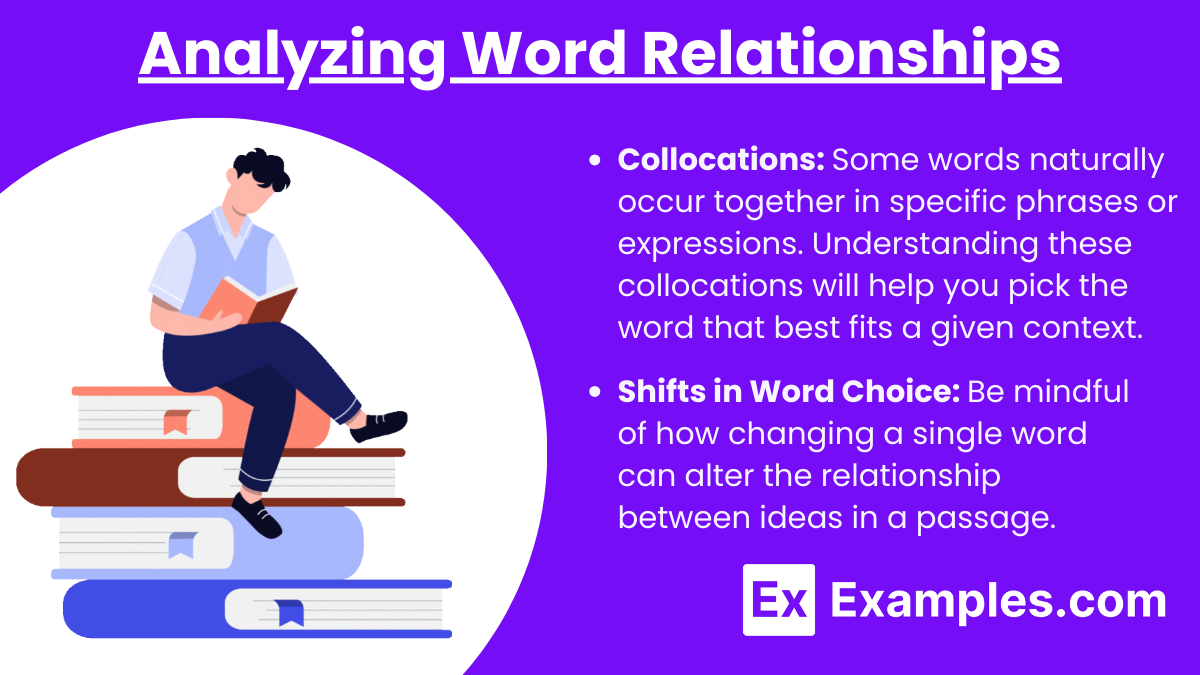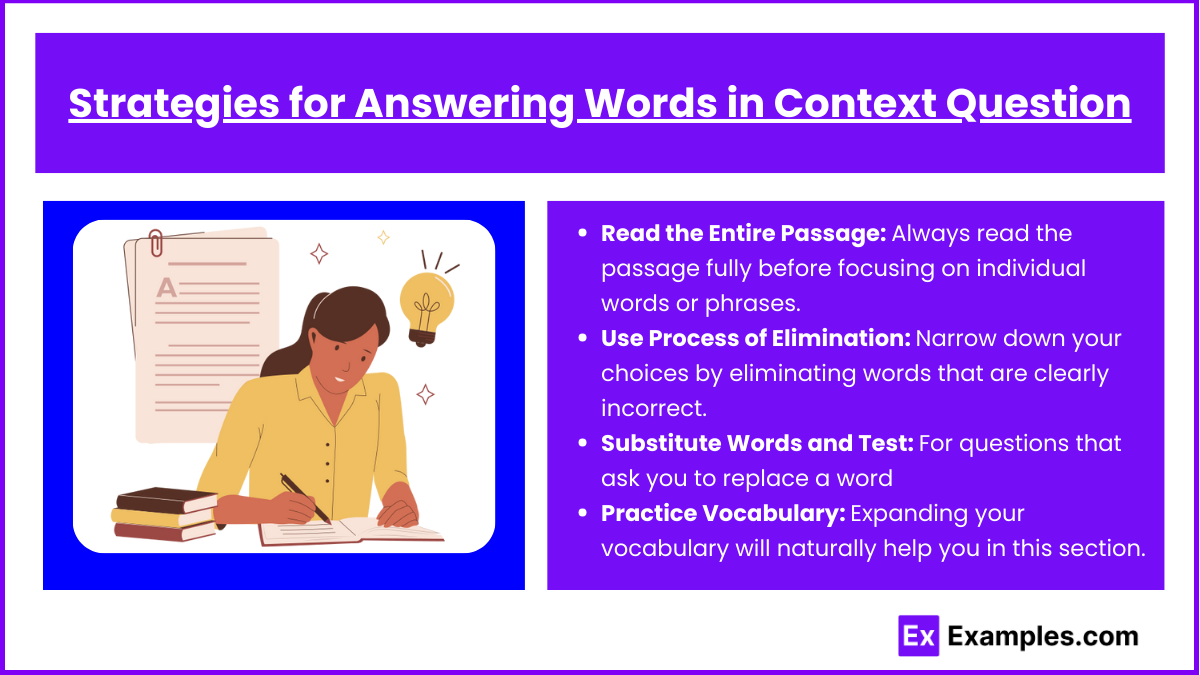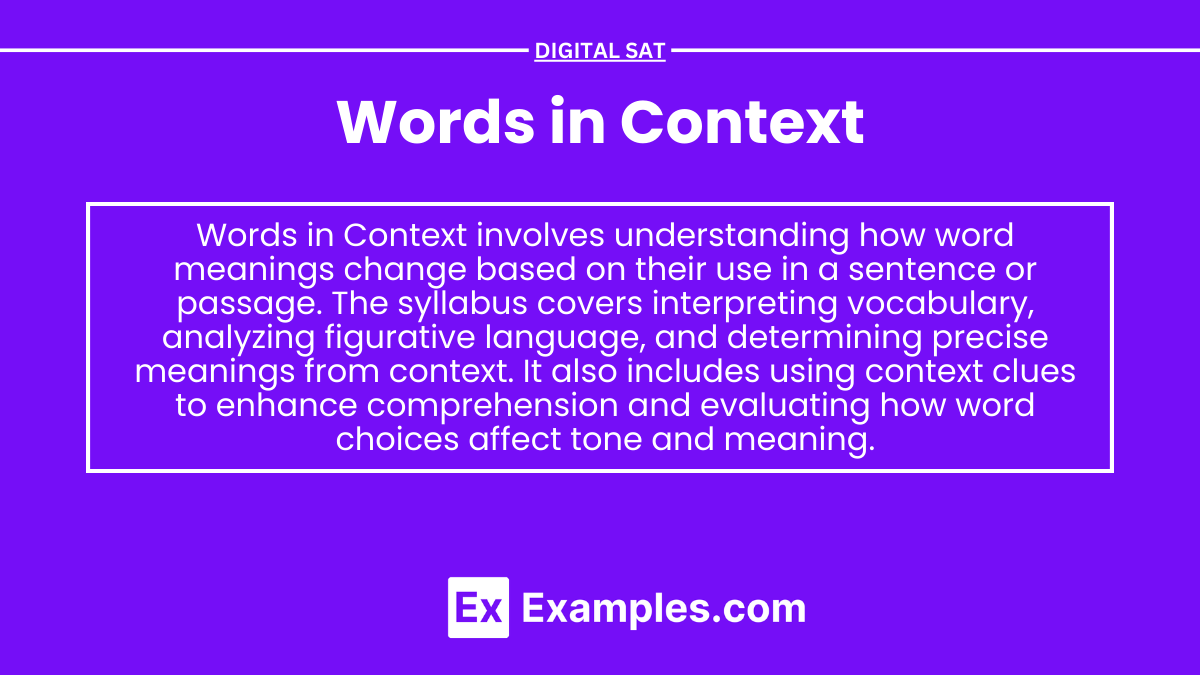The Words in Context section of the Digital SAT focuses on understanding how vocabulary is used within passages. It tests your ability to determine word meanings, analyze connotation, and assess how word choices affect tone and meaning. Success in this section requires strong skills in using context clues, understanding nuances in vocabulary, and recognizing how word choice influences the passage’s overall message.
Learning Objectives
In studying “Words in Context” for the Digital SAT, you should learn to determine the meaning of words and phrases based on how they are used in passages. Focus on understanding how context shapes the meaning of unfamiliar or multiple-meaning words. Practice recognizing shifts in tone, style, and intent based on word choice. Additionally, learn to analyze how an author’s specific vocabulary choices impact the overall meaning and effectiveness of a text, and develop strategies to infer meanings using surrounding context clues.
Types of Context Clues

- Definition Clue: Sometimes, the author directly defines the word within the sentence. Words such as “is,” “means,” or “refers to” can signal a definition.
- Synonym Clue: The author may use a synonym or similar word in the same sentence or in a nearby sentence to help clarify the meaning of the unknown word.
- Antonym Clue: In some cases, the author may use an antonym (a word with the opposite meaning) to contrast with the unfamiliar word. Words like “but,” “however,” or “instead” may indicate an antonym clue.
- Example Clue: Examples provided in the sentence can give you insight into the meaning of the word. Look for phrases like “such as,” “for instance,” or “for example.”
Analyzing Word Relationships

- Questions in the “Words in Context” section may also ask you to analyze the relationships between words. This might include understanding how two words are connected, either as synonyms, antonyms, or through more complex relationships.
- Collocations: Some words naturally occur together in specific phrases or expressions. Understanding these collocations will help you pick the word that best fits a given context. For example, we say “take a picture,” not “make a picture.”
- Shifts in Word Choice: Be mindful of how changing a single word can alter the relationship between ideas in a passage. For instance, switching from “because” to “even though” can completely change the relationship between two clauses.
Strategies for Answering Words in Context Question

- Read the Entire Passage: Always read the passage fully before focusing on individual words or phrases. The broader context is crucial to understanding how a specific word functions in the passage.
- Use Process of Elimination: Narrow down your choices by eliminating words that are clearly incorrect. Often, you can discard choices that don’t fit the tone, meaning, or context of the passage.
- Substitute Words and Test: For questions that ask you to replace a word, mentally substitute each answer choice into the passage to see which one fits best. Consider both meaning and tone when testing different words.
- Practice Vocabulary: Expanding your vocabulary will naturally help you in this section. Focus on learning synonyms, antonyms, and nuanced meanings of commonly tested words.
Choosing the Best Word

- In some questions, you will be asked to choose the best word or phrase to fit the meaning of the passage. To succeed in these questions, focus on:
- Context: Ensure that the word you select logically fits the overall meaning of the passage. Consider both the literal meaning and the tone of the passage when selecting your answer.
- Precision: Look for the word that conveys the most precise meaning. Some options may be close in meaning, but one word might be a more accurate fit.
- Tone Matching: Pay attention to whether the word matches the tone or mood of the surrounding sentences. For example, in a serious or academic passage, avoid overly casual or colloquial words.
Examples
Example 1: Understanding Synonyms in Context
In a passage discussing a CEO’s leadership style, the word “assertive” is used to describe their decision-making. Based on the context, it’s clear that the author views the CEO’s leadership positively, emphasizing their ability to make firm decisions confidently. The word “assertive” suggests a strong, self-assured approach, which fits with the overall tone of respect and admiration for the CEO’s actions.
Example 2: Connotation and Word Choice
In a description of a city’s infrastructure, the author uses the word “metropolis” to convey the scale and sophistication of the city. This choice contrasts with using “urban area” or “town,” which might suggest a smaller or less developed place. “Metropolis” carries connotations of a large, bustling, and perhaps cosmopolitan city, emphasizing the city’s importance and complexity within the passage.
Example 3: Impact of Word Choice on Tone
In a narrative about a challenging climb up a mountain, the word “grueling” is used to describe the journey. This word conveys a sense of exhaustion and extreme difficulty, aligning with the passage’s focus on the physical and mental toll of the climb. Had the author used a milder word like “difficult,” the intensity of the experience would have been less emphasized, altering the tone of the passage.
Example 4: Context Clues for Unfamiliar Words
A scientific passage introduces the term “photosynthesis,” followed by an explanation that plants use sunlight to convert water and carbon dioxide into oxygen and glucose. Even if a reader is unfamiliar with the word, the sentence provides enough context to understand that photosynthesis is the process by which plants produce food and release oxygen. The surrounding details serve as context clues, clarifying the meaning of the term.
Example 5: Subtle Differences in Meaning
In a historical analysis, the author describes a treaty as “controversial” rather than simply “disputed.” The word “controversial” suggests that the treaty not only faced opposition but also sparked significant public debate and differing opinions among various groups. In contrast, “disputed” would have implied that it was contested, but without emphasizing the broader social and political consequences that the word “controversial” brings to the passage.
Practice Questions
Question 1:
In the sentence below, what does the word “elusive” most likely mean?
“The solution to the math problem was elusive, despite hours of effort from the team of experts.”
A) Complicated
B) Confusing
C) Difficult to grasp
D) Incorrect
Answer: C) Difficult to grasp
Explanation:
The word “elusive” in this context suggests that the solution to the problem was hard to understand or obtain. The phrase “despite hours of effort” emphasizes that the team worked hard but still struggled to find the answer. “Complicated” and “confusing” are somewhat related, but “elusive” specifically implies that the solution is out of reach or hard to capture, which aligns best with “difficult to grasp.”
Question 2:
In the context of the sentence below, what does the word “robust” mean?
“The team developed a robust plan to address the unexpected challenges, ensuring the project would succeed under any circumstances.”
A) Simple
B) Strong and effective
C) Inflexible
D) Delicate
Answer: B) Strong and effective
Explanation:
The word “robust” is used to describe a plan that is capable of handling “unexpected challenges” and ensuring success “under any circumstances.” This suggests the plan is strong, well-constructed, and effective. “Simple” and “delicate” would not fit in this context because they don’t convey the strength required to manage unexpected difficulties, and “inflexible” implies a lack of adaptability, which is not supported by the passage.
Question 3:
In the sentence below, what does the word “meticulous” most nearly mean?
“The artist was known for her meticulous attention to detail, spending hours perfecting even the smallest aspects of her work.”
A) Quick
B) Careful and precise
C) Artistic
D) Compulsive
Answer: B) Careful and precise
Explanation:
The word “meticulous” is used to describe the artist’s attention to detail, which suggests she is very careful and precise in her work. The phrase “spending hours perfecting even the smallest aspects” reinforces the idea of thoroughness and precision. “Artistic” doesn’t fully capture the focus on detail, and “quick” would be the opposite of what the sentence describes. “Compulsive” implies a psychological drive rather than careful attention.


